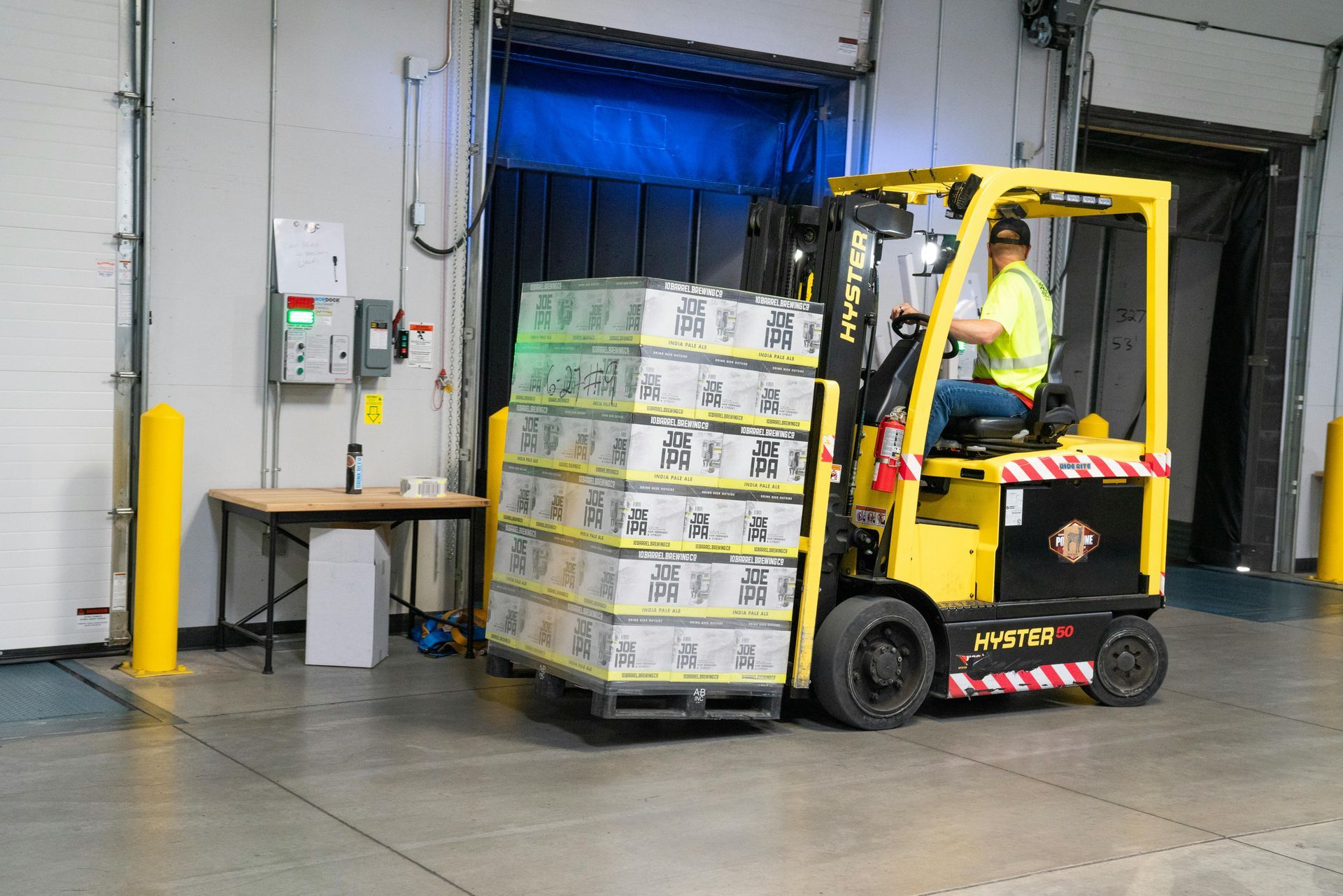Industrial Real Estate Investors
Strategies for Maximizing ROI

Investing in industrial real estate can be a lucrative opportunity if approached correctly. Understanding the different types of properties and investment strategies is key to success in this sector. With growing demand for warehouses and production facilities, many investors are turning their attention to industrial real estate.
As e-commerce continues to expand, industrial spaces like distribution centers and manufacturing facilities play a crucial role in the economy. Knowing the market trends and potential risks can help you make informed decisions. Engaging in this field requires careful planning and a solid strategy that fits your financial goals.
By exploring various investment options and understanding the market dynamics, you can position yourself to take advantage of opportunities in industrial real estate. Whether you are a seasoned investor or just starting, this guide will equip you with valuable insights into this growing market.
Key Takeaways
- Understanding property types aids in making informed investment choices.
- Keeping an eye on market trends helps identify profitable opportunities.
- Effective risk management strategies protect your investments.
Overview of Industrial Real Estate
Industrial real estate plays a crucial role in the economy by providing spaces for manufacturing, warehousing, and distribution. Understanding its definition and significance helps you grasp its increasing importance in today’s market.
Defining Industrial Real Estate
Industrial real estate includes properties used for manufacturing, logistics, and production activities. Common types include warehouses, factories, and distribution centers. These spaces can range from small workshops to large-scale facilities.
Investments in industrial real estate typically focus on properties that support supply chain efficiency. These spaces are essential for companies dealing with the production and transport of goods. Investors seek properties that are strategically located near major transportation routes to maximize accessibility.
Significance in the Economy
The industrial real estate sector is vital for a functioning economy. It supports a wide range of industries, including e-commerce, manufacturing, and logistics. As online shopping grows, demand for distribution and warehouse facilities also increases.
Investing in industrial properties can lead to stable returns. These properties often have longer lease terms, ensuring consistent income.
Additionally, industrial spaces tend to be more resilient during economic downturns compared to other real estate sectors.
You can view industrial real estate as a key player in the modern economy, where efficiency and speed are essential for success.
Types of Industrial Real Estate Properties
Industrial real estate encompasses various property types that serve different functions within the supply chain. Understanding these types can help you make better investment decisions.
Warehouses and Distribution Centers
Warehouses and distribution centers are crucial for storing and distributing goods. They often feature large open spaces with high ceilings to accommodate stacks of products.
These facilities are strategically located near transportation hubs, such as highways and ports, to ensure quick delivery to retailers and consumers.
A modern warehouse might include advanced features like climate control and automated systems for efficiency. You can expect a high rental demand in this sector, especially with the growth of e-commerce, which requires timely order fulfillment.
Manufacturing Facilities
Manufacturing facilities are designed for producing goods. They can handle various activities, from assembly to heavy manufacturing.
These properties often come with specialized equipment and ample power supply, as production can be resource-intensive. Depending on the industry, you may find features like loading docks, cranes, and large power input rooms.
When investing, consider factors like zoning regulations and the proximity to suppliers and markets. A well-placed manufacturing facility can significantly reduce operational costs.
Flex Spaces
Flex spaces combine office and industrial uses, making them versatile. These properties allow businesses to adapt their space according to changing needs.
A typical flex space includes both office areas and warehouses, providing flexibility for logistics, light manufacturing, and creative uses. This adaptability attracts a wide range of tenants.
Investing in flex spaces can offer stable income, as they appeal to startups and established companies seeking cost-effective solutions. Look for spaces that are easy to modify to meet tenant requirements.
Research and Development Parks
Research and development parks focus on innovation and technology. These facilities cater to businesses involved in product development and testing.
Typically located near universities or tech hubs, R&D parks offer collaboration opportunities with experts and researchers. They often feature laboratories, offices, and meeting spaces.
Investing in R&D parks can be profitable as the demand for innovation continues to rise. Properties in these areas often have strong growth potential due to the increasing focus on technology and research.
Investment Strategies
When investing in industrial real estate, it's essential to consider different strategies that align with your financial goals and risk tolerance. Core investments, value-added opportunities, and development projects each offer unique advantages and challenges. Understanding these strategies can help you make informed choices.
Core Investments
Core investments focus on high-quality, stable properties in prime locations. These investments usually involve low risk and provide consistent cash flow. Typically, these buildings are fully leased to reliable tenants with long-term leases.
Consider these key features:
- Location: Properties in established markets with good infrastructure.
- Tenant Quality: Tenants with strong financial backgrounds and credit ratings.
- Long-Lease Terms: Stability through long-term agreements, often 5 years or more.
This strategy is ideal for investors seeking a dependable income stream with minimal management involvement.
Value-Added Opportunities
Value-added investments offer the chance to improve properties and increase their value. Unlike core investments, these often require some level of renovation or management changes. You may focus on properties that are underperforming or need upgrades.
Key aspects include:
- Renovations: Making physical updates to attract higher-quality tenants.
- Operational Improvements: Streamlining management processes to boost efficiency.
- Market Positioning: Adjusting rental rates based on improvements.
This strategy requires more involvement and risk but can lead to significant returns.
Development Projects
Development projects involve constructing new buildings or major renovations of existing ones. This strategy can yield high returns but also comes with greater risks. You should be prepared for uncertainties like zoning regulations, construction costs, and market demand.
Important factors to think about include:
- Feasibility Studies: Assessing the potential success of the project.
- Funding Sources: Securing financing through loans or investors.
- Market Timing: Understanding when to enter the market for maximum impact.
This strategy is suited for those who can handle more risk for higher potential rewards.
Market Analysis
When investing in industrial real estate, understanding the market is crucial. Key factors such as supply and demand, location, accessibility, and economic indicators all play significant roles in making informed decisions.
Assessing Supply and Demand
In industrial real estate, supply and demand directly influence pricing and investment potential. You should analyze current inventory levels and vacancy rates to understand the market's health.
Important metrics include:
- Vacancy Rate: A lower rate often indicates strong demand.
- Absorption Rate: This shows how quickly available properties are being leased.
Researching recent trends can help you predict future movements. The current shift in supply chains impacts what types of properties are in demand.
Location and Accessibility
Location is vital in industrial real estate. Properties near major transportation hubs, highways, and ports often attract more tenants. You should assess the accessibility of each site.
Consider these aspects:
- Proximity to Markets: Being close to key consumer areas reduces transportation costs.
- Transport Links: Access to rail and shipping routes increases property value.
Check zoning regulations as well. They can affect the type of industrial operations allowed on the site, influencing your investment potential.
Economic Indicators
Monitoring economic indicators is essential. These metrics help you gauge the overall economic environment affecting industrial real estate.
Key indicators include:
- GDP Growth Rate: Higher growth usually leads to increased demand for industrial spaces.
- Interest Rates: Rising rates can increase borrowing costs, impacting investment decisions.
You can use these indicators to anticipate how the market may perform in upcoming years. Following regional economic reports aids your understanding of local factors influencing demand and supply.
Financial Considerations
When investing in industrial real estate, understanding the financial aspects is crucial. This includes knowing the capital requirements, calculating operational costs, making informed revenue projections, and navigating tax implications. These factors will significantly influence your investment decisions and potential returns.
Capital Requirements
Before entering the industrial real estate market, you need to be aware of the significant capital needed. This includes the purchase price of the property, closing costs, and potential renovation expenses.
You should also consider the financing options available, such as mortgages or commercial loans. These can vary in interest rates and terms, impacting your overall investment cost.
Investors often need to put down a substantial down payment, typically ranging from 20% to 30%. Having a financial cushion for unexpected expenses is also wise. This helps ensure you remain financially stable as you manage the property.
Operational Costs
Managing an industrial property comes with various operational costs. These may include property management fees, property taxes, insurance, and maintenance expenses.
It's essential to budget for utilities like electricity and water, which can be significant in industrial settings. Depending on the property, you may also need to account for security services and landscaping.
For accurate financial planning, create a detailed budget that itemizes these costs. Monitoring these expenses regularly helps you maintain profitability and adjust your strategy as needed.
Revenue Projections
Revenue from an industrial property primarily comes from leasing. To project potential income, consider the local market rental rates for similar properties. Lease agreements can vary in terms, so understanding your market is key.
It's also wise to factor in vacancy rates. A common benchmark is a 5% to 10% vacancy rate, which accounts for times when the property might be unoccupied.
Consider the potential for rent increases over time, due to demand growth. This can boost your long-term revenue. Having a clear revenue projection is crucial for assessing the investment's profitability.
Tax Implications
Investing in industrial real estate comes with various tax considerations. Property taxes are one of the significant ongoing costs you’ll face. These taxes can vary by location and property value, impacting your overall expenses.
Additionally, you may benefit from depreciation deductions. This can reduce your taxable income, allowing more cash flow for reinvestment.
Working with a tax professional is advisable to understand the specific deductions available to you. This ensures you take full advantage of any tax benefits, optimizing your investment returns.
Risk Management
Effective risk management is crucial for industrial real estate investors. It involves strategies to mitigate potential investment risks, securing appropriate insurance coverage, and ensuring compliance with regulations.
Mitigating Investment Risks
Investing in industrial real estate comes with various risks, including market volatility and property-specific issues. To mitigate these risks, you should conduct thorough due diligence.
Start by analyzing the local market trends. Look at factors like supply and demand, rental rates, and vacancy rates. This information helps you make informed decisions.
Consider diversifying your investments too. Owning different types of properties or locations can reduce overall risk. Additionally, keeping an eye on economic indicators can help you stay prepared for potential downturns in the market.
Insurance Coverage
Having the right insurance is vital in protecting your investment. You should consider different types of insurance, including property insurance, liability coverage, and business interruption insurance.
Property insurance protects against physical damage to the building. Liability coverage safeguards you in case of accidents that occur on your property. Business interruption insurance is crucial if unforeseen events disrupt your operations.
Ensure you regularly review your policies. As your investment grows or changes, your insurance needs may also change. Work with an insurance professional to tailor coverage that suits your specific requirements.
Regulatory Compliance
Regulatory compliance is essential for avoiding legal troubles. You must stay updated on local, state, and federal regulations that affect industrial properties.
Key areas to focus on include zoning laws, environmental regulations, and building codes. Compliance not only protects you from fines but also enhances your property’s value.
Take time to understand and comply with safety regulations too. This includes maintaining proper working conditions and ensuring that the facility meets health standards. Regular audits can help identify areas needing improvement, highlighting your commitment to compliance and safety.
Trends and Future Outlook
As industrial real estate continues to evolve, several key trends are shaping its future. These include technological advancements, the growing impact of e-commerce, and increasing attention to sustainability. Each of these areas plays a critical role in influencing investment strategies and market demand.
Technological Advancements
New technologies are transforming industrial real estate. Automation and robotics are at the forefront, enhancing efficiency in warehouses and distribution centers. These innovations lower operational costs and improve productivity.
In addition, advanced data analytics are helping investors make informed decisions. By analyzing market trends and consumer behavior, you can identify profitable opportunities.
Also, smart building technologies are becoming standard. Features like energy management systems and enhanced security are not just attractive; they are essential for attracting tenants in a competitive market.
The Impact of E-Commerce
The surge in e-commerce is reshaping the demand for industrial properties. With more consumers shopping online, the need for logistics and distribution centers has skyrocketed.
As a result, last-mile delivery facilities are becoming increasingly important. These are the warehouses closer to urban centers that enable quicker deliveries.
Investors are focusing on locations that offer accessibility to major transportation routes. This trend reflects the demand for speed and efficiency in supply chains. Being in the right location can significantly impact your investment returns.
Sustainability in Industrial Real Estate
Sustainability practices are gaining traction in the industrial sector. More investors recognize the importance of green buildings. These properties not only reduce environmental impact but also attract environmentally-conscious tenants.
Many facilities are incorporating renewable energy sources like solar panels. This reduces operational costs and enhances property value over time.
Regulations are also tightening around sustainability standards. Investors need to adapt to remain competitive and compliant. Aligning with these trends can enhance your portfolio’s appeal and profitability in the long run.
By staying informed on these trends, you can make sound investment decisions in the evolving landscape of industrial real estate.
Case Studies
Examining real-world examples of industrial real estate investments provides valuable insights. Successful investments highlight effective strategies, while lessons learned reveal common pitfalls to avoid.
Successful Industrial Investments
In recent years, many investors have found success in the industrial real estate sector. For instance, properties located near major transportation hubs have shown strong demand. Walgreens, in its recent case study, invested in a single-tenant net lease property that catered to distribution needs, maximizing rental income.
Additionally, industrial properties adapted for e-commerce businesses have thrived. These warehouses often feature advanced logistics capabilities. Investors targeted facilities with high ceilings and loading docks to accommodate larger trucks. This adaptability has led to increased occupancy rates and long-term leases, significantly boosting returns.
Lessons Learned from Past Investments
Investors have also learned critical lessons from less successful industrial investments. A common issue is overestimating market demand. Some investors rushed into markets without thorough research, resulting in vacancies.
Another pitfall is neglecting property maintenance. Properties that are not well-kept can lead to tenant dissatisfaction and shortened leases. Investing in regular maintenance can protect your asset's value over time.
Finally, staying aware of market trends is essential. Changes in consumer behavior, especially related to e-commerce, can affect the long-term viability of your investment. A strong understanding of these trends will help you make informed decisions.
Legal and Ethical Considerations
When investing in industrial real estate, legal and ethical considerations are crucial. Understanding these aspects can help protect your investment and reputation.
Legal Requirements:
- Zoning Laws: You must ensure the property complies with local zoning regulations.
- Environmental Regulations: Be aware of laws relating to pollution and land use.
- Building Codes: Confirm that all structures meet safety and construction standards.
Ethical Considerations:
- Fair Housing Compliance: Ensure all actions comply with fair housing laws to prevent discrimination.
- Transparency: Maintain open communication with stakeholders about your investment strategies.
- Community Impact: Consider how your investment affects the local community and environment.
Best Practices:
- Conduct Due Diligence: Research all legal obligations before finalizing any investment.
- Engage Professionals: Consult with legal and real estate experts to navigate complex regulations.
- Promote Sustainability: Aim for eco-friendly practices that benefit both your investment and the environment.
By focusing on these legal and ethical aspects, you can build a responsible and successful industrial real estate investment.
Exiting Strategies
Exiting strategies are vital for industrial real estate investors. They help you realize profits and move on from your investment when the time is right. Here are some common strategies you can consider:
- Direct Sale: You can sell your property directly on the open market. This often involves listing with a real estate agent. It’s straightforward and allows you to cash out.
- 1031 Exchange: This strategy lets you defer paying capital gains taxes by reinvesting the proceeds into a similar property. It’s a great option if you want to maintain your portfolio while delaying tax obligations.
- Lease Options: You might consider offering a lease with an option to buy. This can attract tenants who may turn into buyers later, giving you potential for future profit.
- Joint Ventures: Partnering with other investors can provide more resources. This can be useful if you want to maximize returns on a property you plan to sell.
- Value-Add Improvements: Increase the property's value through enhancements and then sell it for a higher price. This requires an upfront investment but can yield significant returns.
- Holding for Cash Flow: If the market is declining, you might choose to hold onto the property for reliable cash flow rather than selling at a loss.
Each of these strategies requires careful consideration of your financial goals and market conditions. Evaluate your options to determine what aligns best with your investment strategy.
Frequently Asked Questions
Investing in industrial real estate can be complex, and it's important to have clear answers to your questions. This section will address key factors, potential risks, market trends, investment strategies, types of industrial properties, and future projections.
What are key factors to consider before investing in industrial real estate?
Before you invest, consider location, access to transportation, and proximity to major markets. Properties near highways and ports tend to attract tenants quickly.
Evaluate the property’s condition and any necessary improvements. Understanding zoning laws and regulations is also essential as they can impact your investment.
What are the potential risks and rewards of investing in industrial properties?
Investing in industrial real estate can offer high returns but carries risks. Economic downturns can reduce demand, affecting rental income or property values.
Be aware of tenant turnover, as empty properties generate no income. However, long-term leasing agreements can provide stable cash flow, mitigating some risks.
How do market trends affect the value of industrial real estate investments?
Market trends directly influence industrial real estate value. For example, a surge in eCommerce boosts demand for warehouses and distribution centers.
Keep an eye on economic indicators like unemployment rates and consumer spending. Changes in technology and logistics can also affect market conditions.
What strategies do top investors use to identify profitable industrial real estate opportunities?
Successful investors conduct thorough market research. They analyze supply and demand trends to find growth areas.
Networking with real estate professionals can provide valuable insights. Investors often look for properties with potential for value-add renovations.
Can you explain the different types of industrial real estate and their investment potential?
Industrial real estate includes warehouses, manufacturing facilities, and distribution centers. Each type has unique investment potential based on market demands.
For instance, warehouses are essential for eCommerce, while manufacturing sites can attract companies seeking production space. Understand which type aligns with your investment goals.
What are the long-term projections for the industrial real estate market?
The industrial real estate market is expected to grow due to increasing online shopping and supply chain needs. Experts project continued demand for warehouses and logistics centers.
Keep an eye on technological advancements and sustainability trends. These factors will likely shape the future of industrial investment opportunities.
More about Coastline Equity
Property Management Services
 Learn More
Learn MoreOur team will handle all your property needs, offering specialized services such as in-depth inspections, liability management, staff recruitment and training, and round-the-clock maintenance—expert support tailored to the unique requirements of your real estate assets.
About Us
 Learn More
Learn MoreOur dedicated team transforms property management challenges into opportunities. From tenant management to streamlined rent collection and proactive maintenance.
Property Management Excellence
 Learn More
Learn MoreAs a contributing author for Forbes, Anthony A. Luna brings a wealth of expertise and knowledge in the property management industry, real estate sector, and entrepreneurship, providing insights and thought-provoking analysis on a range of topics including property management, industry innovation, and leadership.
Anthony has established himself as a leading voice in the business community. Through his contributions to Forbes, Anthony is set to publish his first book, "Property Management Excellence" in April 2025 with Forbes Books.
Insights
 Learn More
Learn MoreLearn more about Coastline Equity's property management practices & processes and how we support our clients with education and a growth mindset.
Coastline Equity Property Management is your partner as you continue to learn and grow.
News & Updates
Property Management Made Easy
Los Angeles
1411 W. 190th St.,
Suite 225
Los Angeles, CA 90248
Temecula
41743 Enterprise Circle N.,
Suite 207
Temecula, CA 92590
P.O. BOX #1489
TORRANCE, CA 90505






